Louisiana is a state with a rich culture, delicious cuisine, and diverse wildlife. From the alligators lurking in the swamps to the colorful birds soaring through the skies, Louisiana is home to a huge variety of interesting animals.
In fact, the state is so proud of its wildlife that it has officially designated many different animals as state symbols. So, without further ado, let’s take a closer look at the official state animals of Louisiana!

What Is an Official Animal?
An official state animal is a unique and fascinating symbol of a state government in the United States. These animals are often chosen for their cultural or historical significance or for their unique characteristics that align with the values or identity of the state they represent.
For example, the white-tailed deer is the official state animal of Michigan, representing its natural beauty and wildlife. Similarly, the American bison is the official state animal of Wyoming, serving as a symbol of the state’s rugged and untamed wilderness.
Each state has its own unique story and reason for choosing its official animals. For example, some states choose an animal native to the area that plays a vital role in the state’s ecosystem, while others choose animals that have historical significance to the state.
It’s important to note that these designations are not legally binding and do not impose any restrictions or protections on the species in question. Instead, they serve as a symbol of pride and a way to honor the state’s wildlife.
Here are the nine official state animals of the state of Louisiana:
1. Reptile – American Alligator
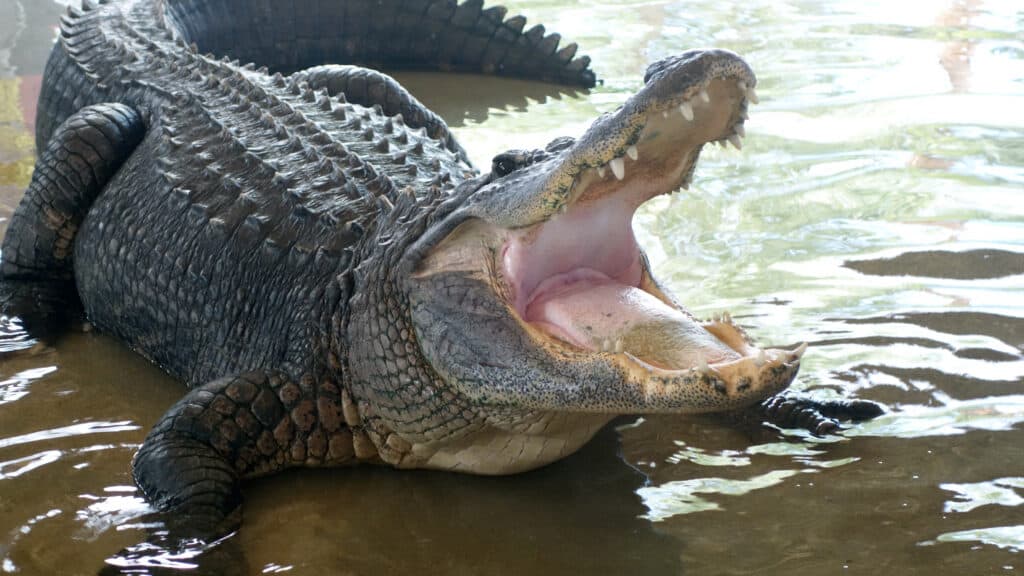
During the breeding season, males produce a deep, rhythmic call to attract mates.
©Ernie Hounshell/Shutterstock.com
The southeast United States, particularly the state of Louisiana, plays host to the mighty American alligator. This powerful reptile proudly takes its place as Louisiana’s official state reptile.
Appearance
- dark-grey skin and a lighter underside
- can grow up to 11-14 feet and weigh up to 1,000 pounds
- short, broad snout with powerful jaws and sharp teeth
Behavior
- semi-aquatic, spending time in swamps, rivers, and lakes
- carnivorous, feeding on fish, birds, mammals, and other reptiles
- solitary and territorial
- uses vocalizations to communicate, including growls and hisses
Characteristics
- cold-blooded, regulating body temperature through basking and water exposure
- life span is around 30 to 50 years
- slow-moving on land but the fast swimmer
Interesting Facts
- plays an important role in maintaining the balance of wetland ecosystems
- During the breeding season, males produce a deep, rhythmic “bellowing” call to attract mates.
- historically hunted for their skin
- listed as endangered in 1967 but now have a sustainable population
Why Is the American Alligator the State Reptile of Louisiana?
The American alligator was designated as the state reptile of Louisiana in 1983. This recognition was due to the alligator’s significance in the state’s history, culture, and ecology.
For centuries, the American alligator has been sought after for its prized skin, and even today, the Louisiana alligator industry continues to be a significant contributor to the state’s economy.
2. Amphibian – Green Tree Frog
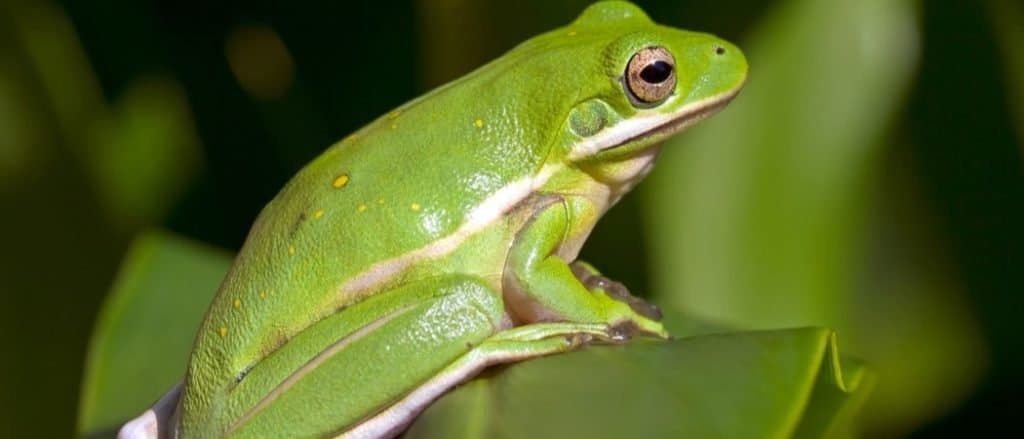
The green
tree frog
is arboreal, living primarily in trees and shrubs near water sources.
©LorraineHudgins/Shutterstock.com
The southeastern United States is home to the green tree frog. Louisiana proudly claims this unique frog as its state amphibian.
Appearance
- bright green, dark green, or sometimes gray in color
- grows up to 2 inches in length
- large, round eyes with distinctive vertical pupils
Behavior
- arboreal, living primarily in trees and shrubs near water sources
- nocturnal, active at night, and spends the day hiding in the vegetation
- feeds on insects, spiders, and other small prey
- good climber, able to cling to smooth surfaces
Characteristics
- moist skin to allow for respiration
- ability to change color to blend in with its surroundings
- lays eggs in water, where the tadpoles metamorphose into adult frogs
Interesting Facts
- distinctive trill to attract mates
- the bright green color helps it to blend in with foliage, making it less noticeable to predators
- can tolerate a wide range of both temperatures and habitats, making it a hardy species
Why Is the Green Tree Frog the State Amphibian of Louisiana?
In 1993, the green tree frog was declared the state amphibian of Louisiana. This recognition was due to the species’ widespread presence in the state and its cultural and ecological significance.
Additionally, the species’ hardiness and ability to adapt to a range of conditions make it a symbol of resilience and survival, values important to the Louisiana people.
3. Dog – Catahoula Leopard Dog

This fierce breed has been recognized as Louisiana’s official state dog for decades.
©Eudyptula/Shutterstock.com
Born and bred for herding and hunting, the Catahoula leopard proudly calls Louisiana it’s home. This fierce breed has been recognized as Louisiana’s official state dog for decades.
Appearance
- a short, smooth, or dense coat that comes in various colors and patterns, including solid, brindle, or leopard-spotted
- muscular, athletic build with a broad head and powerful jaws
- height of 22 to 26 inches and weight of 50-95 pounds
Behavior
- high-energy and independent, with strong instincts for herding and hunting
- protective of family and territory
- good with children but may be wary of strangers
- needs plenty of exercise and mental stimulation
Characteristics
- originally bred for herding cattle and hunting game
- intelligent and trainable, with a strong desire to please its owners
- can be stubborn and challenging to train if not socialized and trained properly
Interesting Facts
- origins are not clear, with some theories suggesting Native American, Spanish, and French influences
- used to track and catch wild pigs in Louisiana’s forests
- unique “glass eye,” with one or both eyes being blue, green, or brown
Why Is the Catahoula Leopard the State Dog of Louisiana?
The Catahoula leopard dog was officially designated as the state dog of Louisiana on July 9, 1979. The breed holds a significant place in the state’s history and culture, making it an appropriate choice as Louisiana’s state dog.
4. Mammal – Louisiana Black Bear
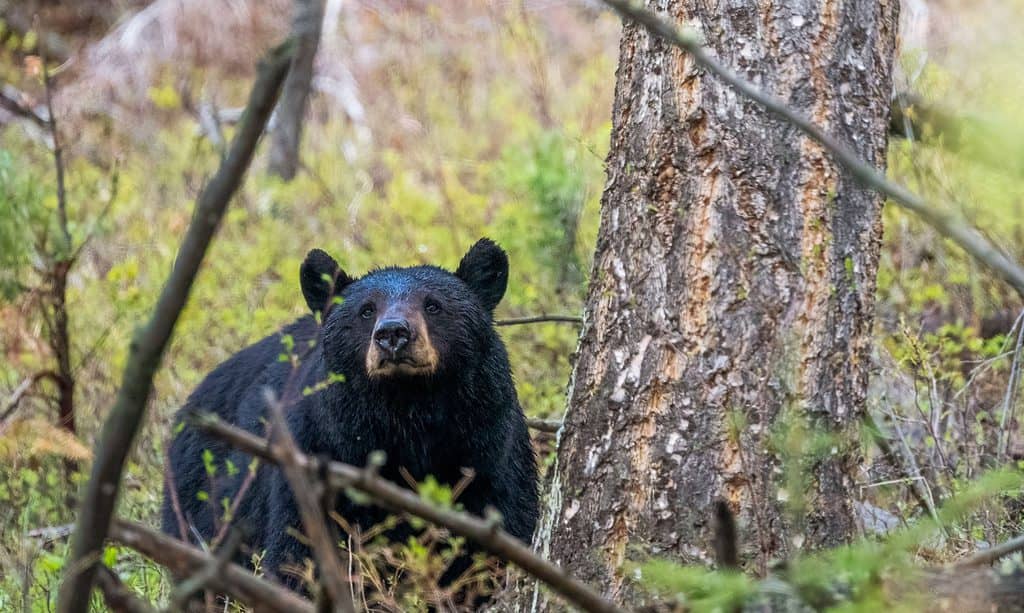
The Louisiana black bear was placed on the endangered species list in 1992 but has since been downgraded to threatened.
©iStock.com/Wirestock
The official state mammal, the Louisiana black bear, is a close relative of the American black bear.
Appearance
- black fur with a distinctive white patch on the chest
- typically weighs between 300 to 500 pounds and stands about 5 to 7 feet tall
- large, rounded ears, a short tail, and a powerful build
Behavior
- a solitary animal, active mainly at night
- feeds on a range of food sources, including berries, nuts, insects, and small mammals
- good climber, able to climb trees to escape danger
- strong sense of smell, used to locate food and avoid danger
Characteristics
- native to Louisiana, with a range that once extended throughout the state
- subspecies due to genetic differences from other black bear populations
Interesting Facts
- has poor eyesight
- placed on the endangered species list in 1992 but has since been downgraded to threatened
- was hunted for its meat, fur, and other products, but today, hunting this species is heavily regulated
Why Is the Louisiana Black Bear the State Mammal of Louisiana?
The Louisiana black bear is a state mammal (designated in 1992) for its historical and natural significance. This bear has a rich cultural history in the state and has played an essential role in shaping the state’s landscapes and ecosystems.
Its recognition as the state mammal serves to highlight the importance of conserving the species and its habitat for future generations.
5. Bird – Brown Pelican
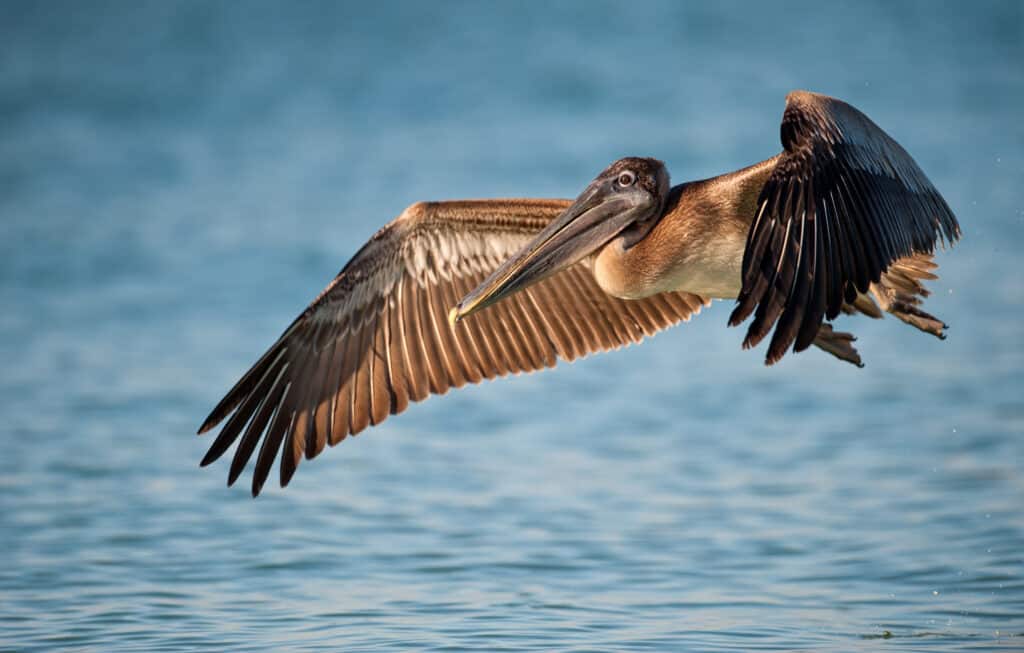
Brown pelicans dive from the air to catch fish in Louisiana waterways.
©Nagel Photography/Shutterstock.com
The brown pelican is a seabird and holds the title of the state bird of Louisiana.
Appearance
- large, distinctive bird with a brownish-gray body, a white head, and a long bill with a hooked tip
- wingspan of 6 to 7 feet and weighs between 4 and 11 pounds
- pouch under the bill used for diving and catching fish
Behavior
- dives from the air to catch prey
- usually seen in flocks near the coast
- feeds on small fish, crustaceans, and other aquatic animals
- a strong flier, able to glide and soar over the water
Characteristics
- found along the Atlantic and Gulf coasts of North America, including the Gulf coast of Louisiana
- colonial nester, with large groups of birds nesting together on offshore islands and coastal marshes
- declined due to habitat loss, pesticide use, and over-fishing but has since rebounded with conservation efforts
Interesting Facts
- can hold up to two gallons of water in its throat pouch
- one of the few pelican species that feed by diving from the air into the water to catch fish
- can fly as high as 100 feet
Why Is the Brown Pelican the State Bird of Louisiana?
The brown pelican holds a special place in the heart of Louisianans, symbolizing the state’s rich heritage and history. From its depiction on the state seal and flag to being officially designated as the state bird in 1966, the brown pelican represents Louisiana’s strong ties to nature and its unique culture.
Known for their remarkable fishing abilities and strong family bonds, these seabirds continue to be a symbol of pride for the state.
6. Freshwater Fish – White Perch
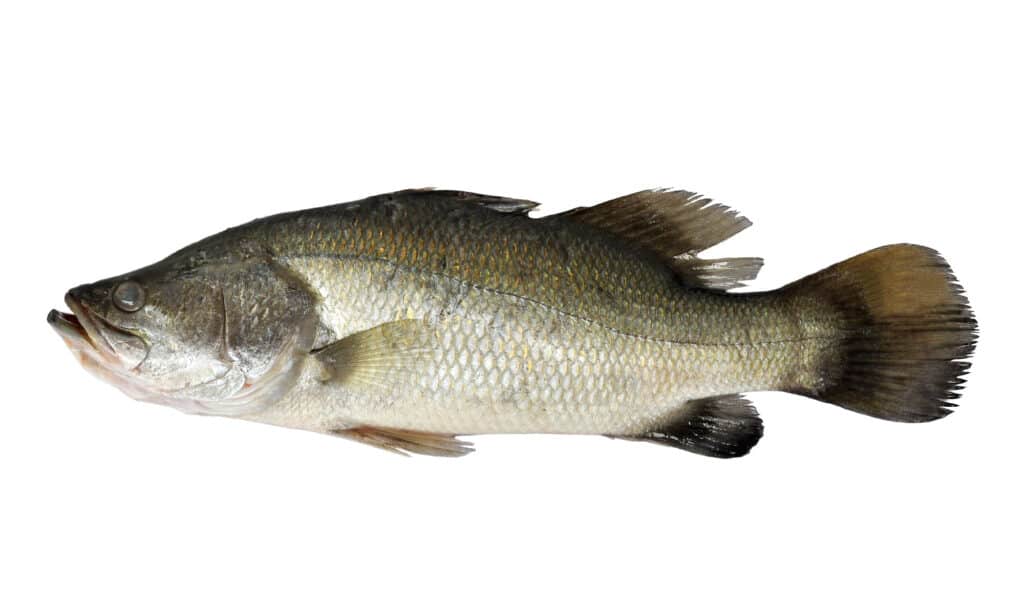
White perch has a small mouth, two dorsal fins, and a forked tail.
©daagron/Shutterstock.com
The white perch is the state freshwater fish of Louisiana.
Appearance
- silvery-white in color with dark gray on its back and sides
- smallmouth, two dorsal fins, and a forked tail
- can reach up to 7 inches and weigh up to 1 pound
Behavior
- found in streams, lakes, and estuaries along the east coast of North America, including Louisiana
- schooling fish that feeds on small fish, crustaceans, and insects
- spawns in freshwater in spring
Characteristics
- not a true perch but a type of bass
- preferred food source for larger predatory fish, such as striped bass and catfish
- popular among sport fishermen in Louisiana and other east coast states
Interesting Facts
- abandons eggs after laying them
- culinary fish with a delicate flavor
- pest in some states due to its ability to harm fisheries by consuming the eggs of other species
Why Is the White Perch the State Freshwater Fish of Louisiana?
The white perch was designated Louisiana’s state freshwater fish in 1993 due to its widespread popularity and significant economic impact, particularly in the gulf coast region. With its delectable taste, it has also been a cherished staple in Louisiana cuisine for generations.
7. Insect – Honeybee
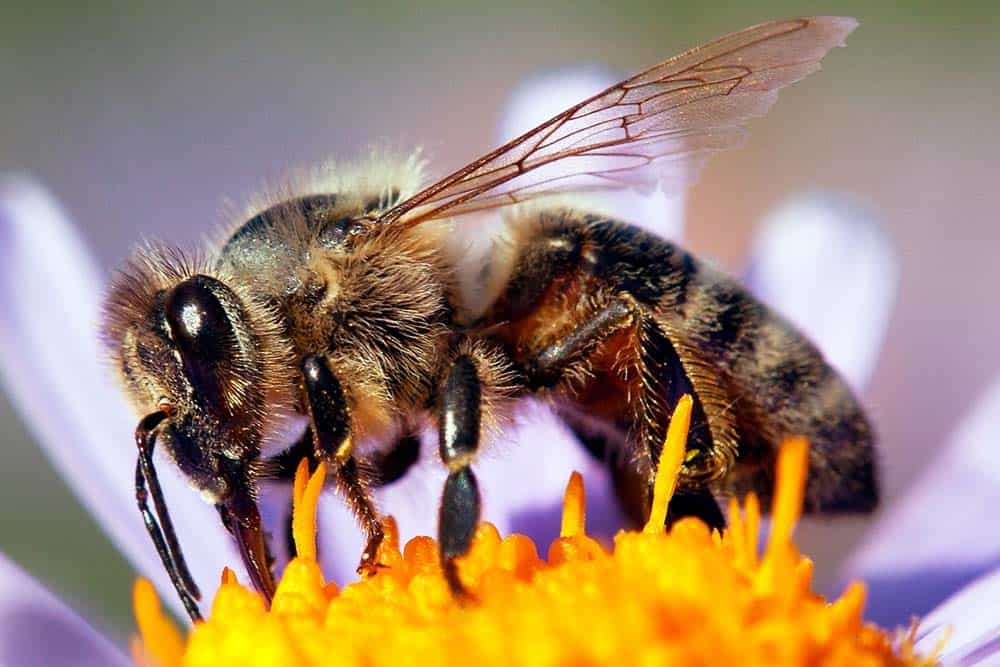
These bees are excellent navigators with complex communication systems.
©Daniel Prudek/Shutterstock.com
The buzzing honeybee was declared the official insect of Louisiana in 1977.
Appearance
- round and fuzzy, typically orange and black
- six legs and two antennae
- wings are located on its back
Behavior
- lives in hives with a queen bee, workers, and drones
- a social insect that relies on cooperation to build and protect its colony
- pollinates plants and collects nectar to make honey
Characteristics
- excellent navigator with a complex communication system
- can fly straight, despite its large body and small wings
- works tirelessly to gather food and care for its colony
Interesting Facts
- one of few species that produce food that humans can consume
- up to 80,000 bees in a single colony
- used for centuries to pollinate crops, producing an estimated $15 billion in crop value each year in the US alone
Why Is the Honeybee the State Insect of Louisiana?
The recognition was due to the significant honey production in the state. The honeybee plays a crucial role in the Louisiana economy through its pollination of various crops, trees, and grasses. The state’s agricultural industry benefits greatly from the tireless efforts of these tiny insects.
8. Marine Fish – Spotted Sea Trout

©IrinaK/Shutterstock.com
Louisiana has different state fishes for saltwater and freshwater. In 2001, Louisiana passed a decree to declare spotted sea trout their state saltwater fish.
Appearance
- Silver in color with round spots in the upper half body
- elongated and streamlined body shape
- average length of 20 to 30 inches, and it can weigh up to three pounds
Behavior
- lives in the shallow waters near the coast
- carnivorous and feeds on smaller fish, shrimp, and crabs
- an active predator that hunts both during the day and at night
Characteristics
- strong swimmer with a powerful tail used for quick bursts of speed
- found near seagrass habitats when temperatures are high
- a lateral line that helps detect vibrations in the water
Interesting Facts
- fighting ability
- considered a prized catch among anglers
- a crucial part of the Gulf of Mexico ecosystem, serving as both prey and predator in the food chain
- female is larger than the male
Why Is the Spotted Sea Trout the State Saltwater Fish of Louisiana?
In Louisiana, the spotted sea trout reigns supreme as the king of saltwater fish. This magnificent species not only captivates the hearts of recreational fishermen but also graces the menus of many of the state’s finest restaurants. This animal has earned its crown as Louisiana’s saltwater fish.
9. Crustacean – Crawfish
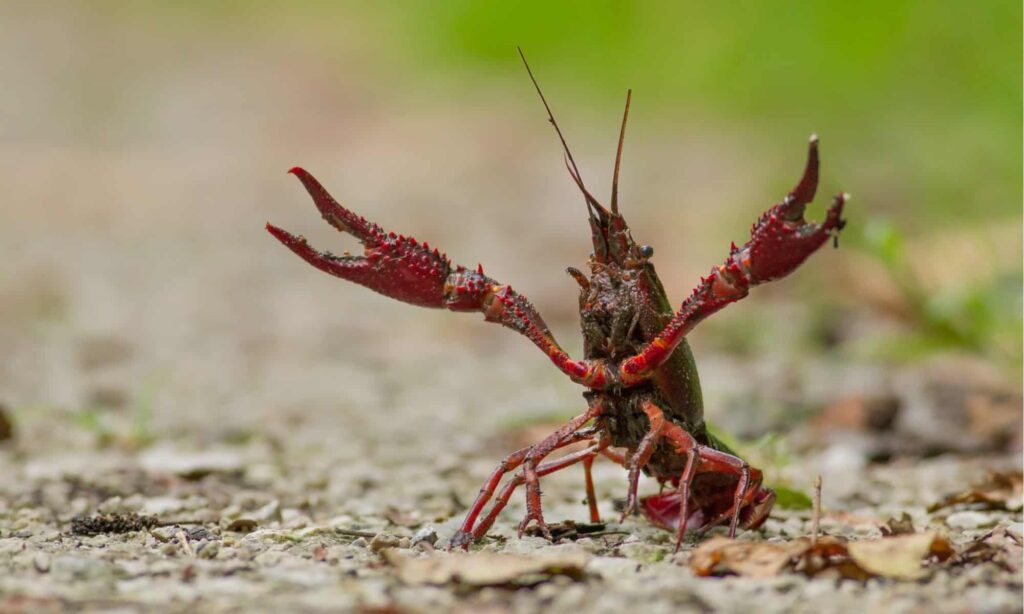
A male uses their claws by pinching or jabbing their rival.
©rugco/Shutterstock.com
The crawfish is the state crustacean of Louisiana and is an integral part of the state’s cuisine and economy.
Appearance
- freshwater crustacean that resembles a miniature lobster
- tough exoskeleton that protects its body
- 10 legs, two acting as large pincers
- ranges in color from brown, orange, red, and green
Behavior
- nocturnal and is most active at night
- scavenger, meaning it feeds on dead animals and plants
- burrows into the mud and builds dens for protection and to regulate its body temperature
- uses its pincers to defend itself against predators
Characteristics
- three to eight-year lifespan
- can grow up to 8 inches long
- highly adaptable and can live in various habitats, from swamps to slow-moving rivers
Interesting Facts
- Louisiana is the largest producer of crawfish in the United States
- sustainable seafood source due to its rapid growth and ability to be farmed
- often used as bait for fishing
Why Is the Crawfish the State Crustacean of Louisiana?
Louisiana is considered the crawfish capital of the world, so it’s no surprise that the state named this crustacean a state animal! In fact, the crawfish was adopted as the state crustacean in 1983 as a testament to this animal’s importance to local culture and cuisine. The crawfish was a favorite food for even the state’s first residents – as it continues to be today.
Conclusion
Louisiana proudly displays its wild side with its official state animals, each one an incredible representation of the state’s diverse and abundant wildlife. From the graceful, iconic brown pelican to the mighty Louisiana alligator, these symbols of Louisiana leave a lasting impression.
These state animals remind us not only of the beauty of Louisiana but of our responsibility to protect and preserve it for future generations to admire. These official state animals are more than just symbols; they are ambassadors of the natural wonders of Louisiana!
The photo featured at the top of this post is © meunierd/Shutterstock.com
Thank you for reading! Have some feedback for us? Contact the AZ Animals editorial team.






